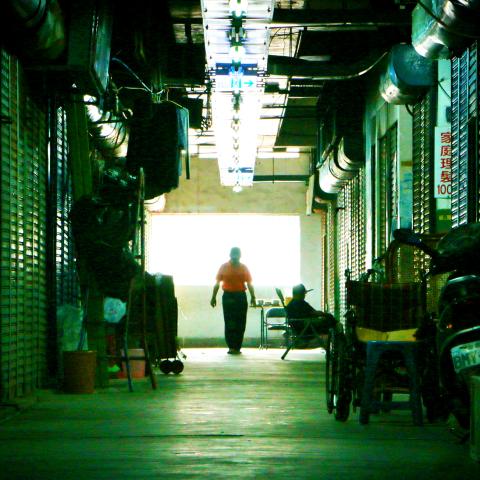When Tyson Skriver moved to Hsinchu three years ago, he explored the city with his camera. But it wasn’t until he attended a photo walk in Taipei’s dilapidated Nanjichang community (南機場) earlier this year that he was reminded of how much he enjoyed events with a deeper significance: Nanjichang has been trying to revitalize itself through numerous urban renewal projects such as community gardens and barista training for high school dropouts.
Skriver eventually organized a photo walk of his own in Hsinchu after some prompting from a friend. The Hsinchu photo walk, which takes places on Sunday beginning at 1:30pm, will introduce participants to the history of the 300-year old “Windy City.”
Starting at Hsinchu Train Station (新竹火車站), it will cover attractions including the Hsinchu Moat (新竹護城河) and City God Temple (城隍廟), which, according to Skriver, “is an excellent spot to grab a quick bite to eat and snap photos of the crowds pushing their way through.”

Photo courtesy of Tyson Skriver
Also along the route are lesser-known locations such as Dongmen Market (東門市場) and the historic Lane 36 on Dongqian St (東前街36巷), dubbed “Dark Street” since little light seeps through the compact, narrow buildings. The tiny street is also the birthplace of modern-day Hsinchu, founded in 1711 by a settler from China’s Fujian province.
Though the Hsinchu Moat, which boasts the title of being the last remaining moat in Taiwan, has drawn more visitors over the years, the Dark Street seems have to been largely neglected and forgotten.
“Only a small wooden sign above the lane indicates its age and significance,” Skriver says.
In addition to learning some history and honing one’s photography skills, the walk will also be a good opportunity to meet other people who are also interested in photography.
Skriver says photo walks are becoming more popular in Taiwan for this reason — though it’s easy to share and “like” photos on social media platforms such as Instagram, there is no face-to-face interaction. Photo walks fill that void.
He adds that it’s always interesting to see what different photographers decide to focus on as it provides a window into how they interpret the world around them. For instance, while some might choose to photograph beautiful flower petals set against a dilapidated building, others might choose to focus on the rust on the building’s facade.
“If you want to see the world through someone else’s perspective, take a look at their photos,” Skriver says.
If you plan on attending, in addition to a camera, remember to bring some sunscreen.

This month the government ordered a one-year block of Xiaohongshu (小紅書) or Rednote, a Chinese social media platform with more than 3 million users in Taiwan. The government pointed to widespread fraud activity on the platform, along with cybersecurity failures. Officials said that they had reached out to the company and asked it to change. However, they received no response. The pro-China parties, the Chinese Nationalist Party (KMT) and Taiwan People’s Party (TPP), immediately swung into action, denouncing the ban as an attack on free speech. This “free speech” claim was then echoed by the People’s Republic of China (PRC),

Exceptions to the rule are sometimes revealing. For a brief few years, there was an emerging ideological split between the Democratic Progressive Party (DPP) and Chinese Nationalist Party (KMT) that appeared to be pushing the DPP in a direction that would be considered more liberal, and the KMT more conservative. In the previous column, “The KMT-DPP’s bureaucrat-led developmental state” (Dec. 11, page 12), we examined how Taiwan’s democratic system developed, and how both the two main parties largely accepted a similar consensus on how Taiwan should be run domestically and did not split along the left-right lines more familiar in

As I finally slid into the warm embrace of the hot, clifftop pool, it was a serene moment of reflection. The sound of the river reflected off the cave walls, the white of our camping lights reflected off the dark, shimmering surface of the water, and I reflected on how fortunate I was to be here. After all, the beautiful walk through narrow canyons that had brought us here had been inaccessible for five years — and will be again soon. The day had started at the Huisun Forest Area (惠蓀林場), at the end of Nantou County Route 80, north and east

Specialty sandwiches loaded with the contents of an entire charcuterie board, overflowing with sauces, creams and all manner of creative add-ons, is perhaps one of the biggest global food trends of this year. From London to New York, lines form down the block for mortadella, burrata, pistachio and more stuffed between slices of fresh sourdough, rye or focaccia. To try the trend in Taipei, Munchies Mafia is for sure the spot — could this be the best sandwich in town? Carlos from Spain and Sergio from Mexico opened this spot just seven months ago. The two met working in the